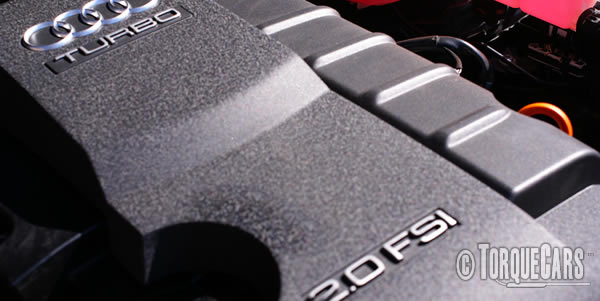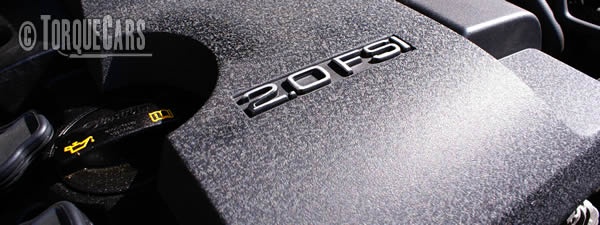Looking at problems and issues on the 2.0 TFSi engine
"Tuning the 2.0 TFSi engine"

Due to concerns about emissions and tighter controls the 2.0 TFSi engine was born and contains a number of major revisions to enhance engine efficiency. The 1.8T engine was retired and replaced with a more powerful turbo charged 2.0 FSi unit.
The most notable revision is the introduction of direct injection allowing very fine control over fuelling and as well as the extra economy on offer the engine provides a lot of extra performance. Because the fuel is injected directly into the cylinder it has the effect of cooling the intake charge, reducing the risk of detonation and allowing much higher cylinder pressures to be used. Plus the fuel delivery can be very precisely controlled and trimmed to suit engine load.
Direct injection has been a major enhancement to diesel engines and it is nice to see this innovation finding its way into petrol engines.
Variants of the 2.0 TFSi find their way across the entire Audi range and this is certainly the petrol engine of choice. Power levels ranged from 197bhp to 265bhp depending on the model with the S3 and TT getting the top power versions.
A few engines had minor internal revisions and slightly altered compression ratios, the 220bhp BUL engine (from the Limited Edition Quattro) is a good example and these respond better to custom remaps than standard engines.
For serious power gains on the TFSi you are looking at an uprated fuel pump (the S3 injectors are a good upgrade option on tuned 2.0TFSi engines to deliver the fuel), sports cat and manifold, cat back exhaust system, high flow air intake and a remap. The weak spots which we will highlight below can be easily remedied and avoided if watched. We do recommend the addition of an uprated non atmospheric diverter valve for mild tuning and standard cars because the original units were not that reliable.
With just a remap on a stock engine you can raise the power from the baseline 200bhp or 220bhp to around 240bhp and although an uprated diverter valve is recommended it is not an essential. Making the remap a very cost effective way to add more power. Adding the other performance parts you should be able to hit the 280bhp mark and if you uprate the turbo to a KO4 unit you should reach around the 350bhp mark fairly easily. A bigger Garret turbo unit would be required if you want to achieve power figures around the 300-600bhp mark.
Cambelt changes should happen at least every 5 years and we would recommend annual oil changes, the recommended long life service is very convenient but you want to keep the car in top condition bear in mind that oil does degrade and pick up contaminants.
To keep your engine in perfect condition you must use the correct grade of oil and stick to a premium brand of fully synthetic. If your garage recommend a semi synthetic or worse still something that isn't 5w30 or VW503 00, VW503 01 or VW504 00 specific you don't really want to let them near your car.

The 2.0 TFSi engines provide excellent efficiency turning every drop of fuel in power which is good for economy but there are 2 well documented problems to look out for. Regard these items as service items rather than a manufacturing defect and as long as you check them you should have no trouble at all.
Cam follower wear.
The main weak spot is the cam follower located below the high pressure mechanical fuel pump. it has a low friction coating on it a bit like "Teflon". The follower resembles a thimble that sits on the bottom of the fuel pump. Check this every few years or at 30,000 miles for wear.
This fault was altered in later models with a different cam lobe set up, the 220bhp BUL engines are not affected by this issue.
You are looking out for the coating wearing off, if it has worn down and exposes a metal surface this causes very quick wear through the follower and damages the cam shaft. The first you'll know about it is in lost fuel pump pressure and a check engine warning light coming on. It is a simple check that most drivers can perform. Be very careful about the extremely high fuel pump pressures and ensure the pressure is released from the system, a jet of fuel at this pressure could potentially cut through bone or at the very least cause major injury!
Carbon Build up.
The other commonly reported problem is that of carbon build up on the valves caused by the direct injection, Although it is a common issue with engines of this type the V6 and V8 engines are more prone due to their lower RPM characteristics. The build up happens because the fuel is not being injected over the valves and this would keep the valves nice and clean.
When the engine is cold the unburned particles are dumped back into the intake, and it is these that foul up the intake. So avoiding short journeys and making sure the engine gets up to operating temperature as quickly as possible will prevent this issue.
After 70,000 miles a decoke is recommended, it does depend on the sort of driving you do though. Adding BG44K to the fuel once a year will keep the engine, injectors and exhaust nice and clean but sadly wont clean the intake valves.
Larger capacity direct injection engines are even more prone to carbon build up issues. The carbon build up will rob you of power rather than do any major damage but cleaning out the head will dramatically increase the performance and economy. (An addition of BG44K to my engine raised the MPG from 31.4 to 37 mpg for a similar journey. AND I HAVE NOT BEEN PAID TO SAY THIS.)
We have not seen evidence that proves that water/alcohol injection cleans the intake valves with some owners of water injection engines still having the carbon build up issue (biofuels like alcohol are not recommended on FSI engines anyway). Breather catch tanks are also suggested as a prevention of this problem but again we have heard of owners with these devices still suffering from Carbon build up.
They say prevention is better than cure so what can be done to prevent this carbon build up issue. Using good quality clean burn fuel free of bio elements, the higher octane fuels also tend to burn cleaner. Get the engine up to temperature as soon as you can (don't idle it but just drive it steadily at around 2000rpm till it warms up) and keep the engine operating at 3000rpm for 15 minutes per week. At this RPM range the engine is designed to run hotter and this can help burn off some of the carbon deposits.
Keep an eye on the recirculation valve, the oil this sprays into the intake when it goes is cited as a major cause of the carbon build up. If you notice high oil consumption then get this valve checked ASAP. (TorqueCars regards high oil consumption as over 0.5 litres per 1000 miles.)

Cleaning the head is most effectively done by removal and refitting but due to the expense we'd recommend you get the head flowed and ported whilst it is off. We have seen some excellent results from intake cleaners that are sprayed at high pressure into the intake, these are not DIY sprays though. An inspection probe through the intake or via the spark plugs will give an indication on the state of carbon build up allowing you to make an informed decision.
The DIY spray cans of carbon cleaner do at best a minor job, the trick is delivering the cleaner evenly to all of the valves you'll typically see the cylinders closest to the vacuum line getting the most benefit from these. For best results take off the intake manifold and spray the cleaner directly onto the problem area and leave it to soak in. (Always follow the manufacturers instructions though, I don't doubt that some formulations should be left on for long periods of time.)
Driving the engine at just over 3000 RPM raises the temperature and puts the engine into a "cleaning mode" where it runs leaner and hotter clearing out a lot of the carbon build up inside the engine, so try to hit this sweet spot as often as you can and for at least 15 minutes per week.
To discuss any points raised in this article please join our forum.
If you liked this page please share it with your friends, drop a link to it in your favourite forum or use the bookmarking options to save it to your social media profile.
Check out TorqueCars new YouTube channel, and see their awesome new content...
Feedback
Please use our forums if you wish to ask a tuning question, and please note we do not sell parts or services, we are just an online magazine.
Help us improve, leave a suggestion or tip
